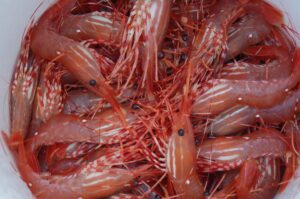
A new report on the effects of small amounts of hydrocarbons on Port Valdez shrimp is now available. The report was approved by the board of directors during the May board meeting.
News release:
Are shrimp caught in Port Valdez contaminated by Alaska North Slope crude oil? The council recently worked with scientists at the National Auke Bay Lab in Juneau to answer that question.
The terminal’s treatment cleans most of the crude oil hydrocarbons from the ballast water that arrives on oil tankers, however small amounts of hydrocarbons from various sources still make it into Port Valdez. Since the early 2000’s the amount has declined by about 90%, in part because all tankers in Prince William Sound are now double-hulled, which means that most ballast water is typically separated from the oil cargo tanks and does not need to be treated at the facility. In addition, decreased oil flow through the pipeline means fewer tankers and consequently less ballast water that requires treatment. Improvements in ballast water treatment processes have further lowered the discharge of hydrocarbons from the terminal.
Oil detected in mussels raise concern for shrimp
The council has been monitoring mussels and sediments in the region for the last 21 years. Since then, traces of hydrocarbons from the terminal and tanker operations have always been detected in the samples taken in Port Valdez.
While the council’s research shows that the amount is small and has been declining in recent years, these detected levels of hydrocarbons in mussels raised concerns among those who harvest shrimp from the area, prompting the council to test hydrocarbon levels in shrimp from the port.
Study results
The study determined that the shrimp’s exposure to hydrocarbons from the terminal does not pose a human health risk. Very low levels of hydrocarbons were found in samples closest to the terminal. The study also compared the amount of oil found in various parts of the shrimp, as well as amounts found in different species of shrimp. The highest levels of hydrocarbons found in the study were in the eggs of pink shrimp, where the average concentration was 630 parts per billion, well below contaminant levels considered unsafe to eat. No evidence of hydrocarbon contamination was found in the shrimp’s tail, which is the part usually consumed. Researchers, however, suggested further study to determine whether the hydrocarbon levels detected in the eggs have an effect on the shrimp’s development.
Read the full report here: Polynuclear aromatic hydrocarbons in Port Valdez shrimp and sediment